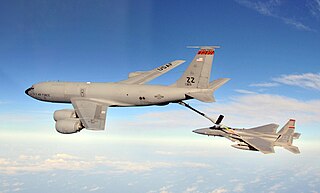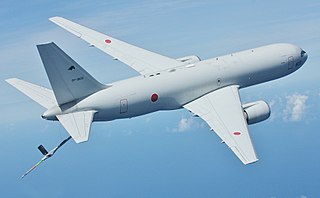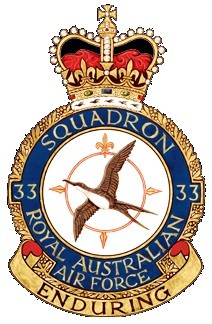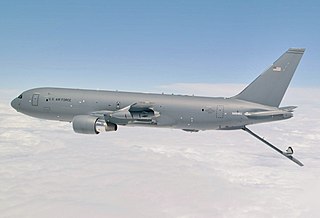
The Boeing KC-135 Stratotanker is an American military aerial refueling tanker aircraft that was developed from the Boeing 367-80 prototype, alongside the Boeing 707 airliner. It has a narrower fuselage and is shorter than the 707. Boeing gave the aircraft the internal designation of Model 717. The KC-135 was the United States Air Force (USAF)'s first jet-powered refueling tanker and replaced the KC-97 Stratofreighter. The KC-135 was initially tasked with refueling strategic bombers, but it was used extensively in the Vietnam War and later conflicts such as Operation Desert Storm to extend the range and endurance of US tactical fighters and bombers.

The Airbus A310 is a wide-body aircraft, designed and manufactured by Airbus Industrie, then a consortium of European aerospace manufacturers. Airbus had identified a demand for an aircraft smaller than the A300, the first twin-jet wide-body. On 7 July 1978, the A310 was launched with orders from Swissair and Lufthansa. On 3 April 1982, the first prototype conducted its maiden flight, and the A310 received its type certificate on 11 March 1983.

Future Strategic Tanker Aircraft (FSTA) was a British project to procure Airbus A330 Multi Role Tanker Transport aerial refuelling (AR) and air transport (AT) aircraft for the Royal Air Force, to replace older models such as the VC10s and TriStars.

The Airbus A310 MRTT Multi-Role Tanker Transport is a military air-to-air refuelling, or in-flight refuelling tanker transport aircraft, capable of operating multi-role missions. The A310 MRTT tanker aircraft is a subsequent development from the earlier Airbus A310 MRT Multi-Role Transport, which was a military transport aircraft for passengers, cargo, and medical evacuation. The A310 MRT and A310 MRTT are both specialist military conversions of existing airframes of the civilian Airbus A310-300C wide-bodied passenger jet airliner.

The Airbus A330 Multi Role Tanker Transport (MRTT) is a European aerial refuelling and military transport aircraft based on the civilian Airbus A330. A total of 16 countries have placed firm orders for approximately 68 aircraft, of which 51 had been delivered by 30 November 2020. A version of the A330 MRTT, the EADS/Northrop Grumman KC-45, was selected by the United States Air Force for its aerial tanker replacement programme, but the programme was cancelled.

The Boeing KC-767 is a military aerial refueling tanker and transport aircraft developed from the Boeing 767-200ER. The tanker received the designation KC-767A, after being selected by the U.S. Air Force (USAF) initially to replace older KC-135Es. In December 2003, the contract was frozen and later canceled due to corruption allegations.

The Royal Canadian Air Force is the air and space force of Canada. Its role is to "provide the Canadian Forces with relevant, responsive and effective airpower". The RCAF is one of three environmental commands within the unified Canadian Armed Forces. As of 2020, the Royal Canadian Air Force consists of 12,074 Regular Force and 1,969 Primary Reserve personnel, supported by 1,518 civilians, and operates 258 manned aircraft and nine unmanned aerial vehicles. Lieutenant-General Eric Kenny is the current commander of the Royal Canadian Air Force and chief of the Air Force Staff.

No. 33 Squadron is a Royal Australian Air Force (RAAF) strategic transport and air-to-air refuelling squadron. It operates Airbus KC-30A Multi Role Tanker Transports from RAAF Base Amberley, Queensland. The squadron was formed in February 1942 for service during World War II, operating Short Empire flying boats and a variety of smaller aircraft. By 1944 it had completely re-equipped with Douglas C-47 Dakota transports, which it flew in New Guinea prior to disbanding in May 1946.

The Boeing CC-137 is a retired transport and tanker aircraft which served with the Canadian Forces from 1970 to 1997. The Boeing 707-347C aircraft provided long range passenger transport for the military, VIP transport for government and air-to-air refueling for fighters such as the CF-116 Freedom Fighter and CF-18 Hornet. It was replaced by the Airbus CC-150 Polaris in the transport role and much later in the tanker role.
Air transports for heads of state and government are, in many countries, provided by the air force in specially equipped airliners or business jets. One such aircraft in particular has become part of popular culture: Air Force One, used by the President of the United States and operated by the United States Air Force. Other well known official aircraft include the Russian presidential aircraft, the British Royal Air Force VIP aircraft, the French Cotam 001, the Royal Canadian Air Force VIP aircraft, the German Konrad Adenauer, the Royal Australian Airforce VIP aircraft, the Japanese Air Force One, the South Korean Code One, the Indian Air India One, the Brazilian Air Force One, and the Israeli Wing of Zion.

437 Transport Squadron is a unit of the Canadian Armed Forces under the Royal Canadian Air Force, based at CFB Trenton in Ontario. The unit operates the CC-150 Polaris, and is responsible for long range military and VIP transportation.
The Royal Canadian Air Force (RCAF) maintains specialised aircraft to transport Canada's monarch and/or other members of the royal family, the governor general, prime minister, other senior members of the Government of Canada, and other dignitaries. A small fleet of dedicated executive government transport aircraft are organised into two RCAF squadrons. Other RCAF combat and transport helicopters and fixed-wing aircraft, chartered civilian aircraft, and occasionally scheduled commercial flights may also be used to meet Canada's VIP air transport requirements.

The Royal Australian Air Force operates a number of specialised aircraft to transport the King of Australia and other members of the Royal Family, the Governor General of Australia, the Prime Minister of Australia, senior members of the Australian government and other dignitaries.

The EADS/Northrop Grumman KC-45 was a proposed aerial refueling tanker aircraft based on the Airbus A330 MRTT. The United States Air Force (USAF) had ordered 179 KC-45As in the first stage of replacing the aging Boeing KC-135 Stratotanker tankers currently in service. However, the contest was reopened in July 2008, after Boeing's protest of the award was upheld. In response to the new contest, on 8 March 2010, Northrop Grumman announced it was abandoning its bid for the new contract, with its CEO stating that the revised bid requirement favoured Boeing. On 20 April 2010, EADS announced it was re-entering the competition and entered a bid with the KC-45. Eventually, the USAF selected the Boeing KC-46 Pegasus.

The Boeing C-137 Stratoliner is a retired VIP transport aircraft derived from the Boeing 707 jet airliner used by the United States Air Force. Other nations also bought both new and used 707s for military service, primarily as VIP or tanker transports. In addition, the 707 served as the basis for several specialized versions, such as the E-3 Sentry AWACS aircraft. The designation C-18 covers several later variants based on the 707-320B/C series. The C-137 should not be confused with the similar Boeing C-135 Stratolifter; although they share a common ancestor the two aircraft have different fuselages, among other structural differences.

The Boeing KC-46 Pegasus is an American military aerial refueling and strategic military transport aircraft developed by Boeing from its 767 jet airliner. In February 2011, the tanker was selected by the United States Air Force (USAF) as the winner in the KC-X tanker competition to replace older Boeing KC-135 Stratotankers. The first aircraft was delivered to the Air Force in January 2019. The Air Force intends to procure 179 Pegasus aircraft by 2027.

Omega Aerial Refueling Services Incorporated is an American aviation company that provides aerial refueling services for military customers.
AirTanker Services Limited, incorporated in England and Wales on 14 July 2007, is a private limited company in the United Kingdom, operating as AirTanker, a British aircraft leasing and operating company. Under contract to the British Government, it provides a fleet of fourteen Airbus A330 MRTT multi-role tanker transport aircraft, known by the British military service name Voyager, to the Royal Air Force (RAF) as its primary tanker aircraft for aerial refuelling, troop and cargo transport, and aeromedical roles. For additional revenue, AirTanker operates air charter flights using reserve aircraft, operating as a civilian airline.

The Royal Air Force VIP Voyager, identified with the military registration of ZZ336, and more recently named by the Royal Air Force (RAF) as Vespina since June 2020, refers to a customised RAF Voyager KC2 (A330-243MRTT) owned by the AirTanker Services and operated under lease by the Royal Air Force that is the first principal VIP transport aeroplane for the British royal family, the Prime Minister, and British government ministers. Whilst the RAF operates the United Kingdom's fleet of fourteen Voyagers, a militarised tanker transport aircraft; ZZ336 Vespina, the VIP Voyager refers specifically to one individual Voyager KC2 aircraft now painted in a United Kingdom livery, and fitted with secure satellite communications system, missile detection, 58 business-class seats, 100 standard seats, and media facilities, similar to other dedicated air transports of heads of state and government.

The Airbus CC-330 Husky is an in-development Royal Canadian Air Force version of the Airbus A330 MRTT based on the civilian Airbus A330. Nine aircraft will replace the existing Airbus CC-150 Polaris fleet of five aircraft in the strategic transport and air refuelling roles.



















